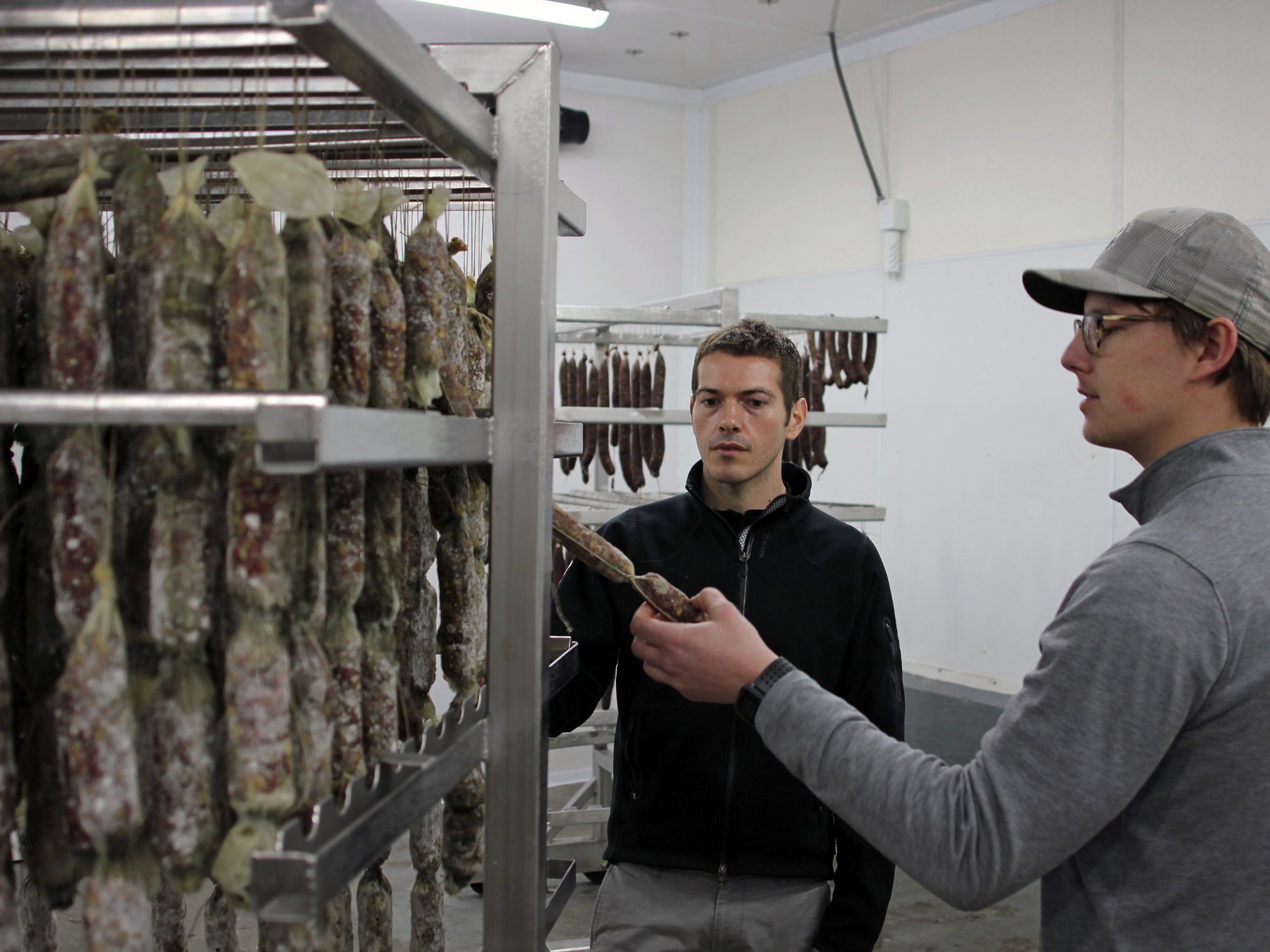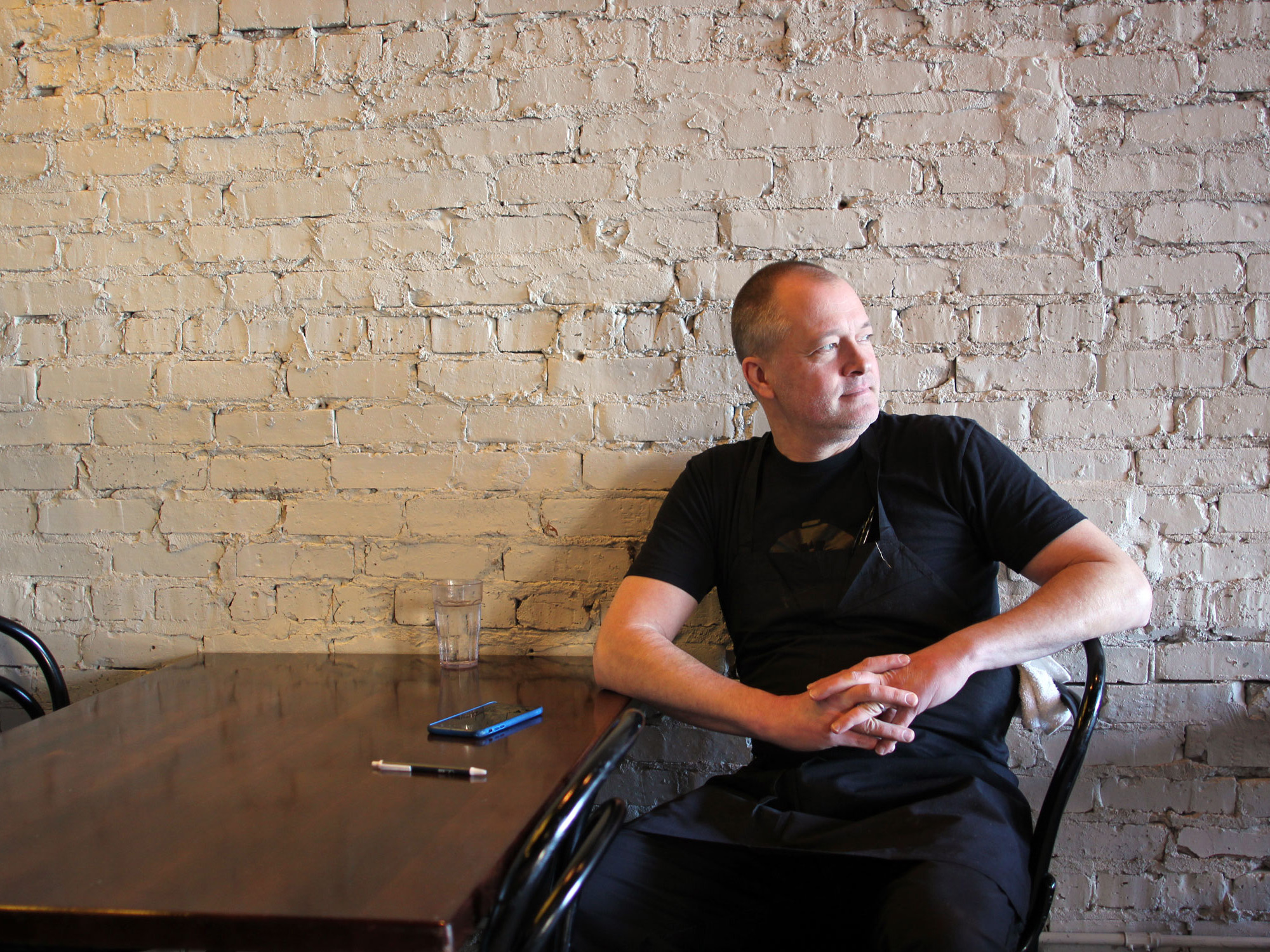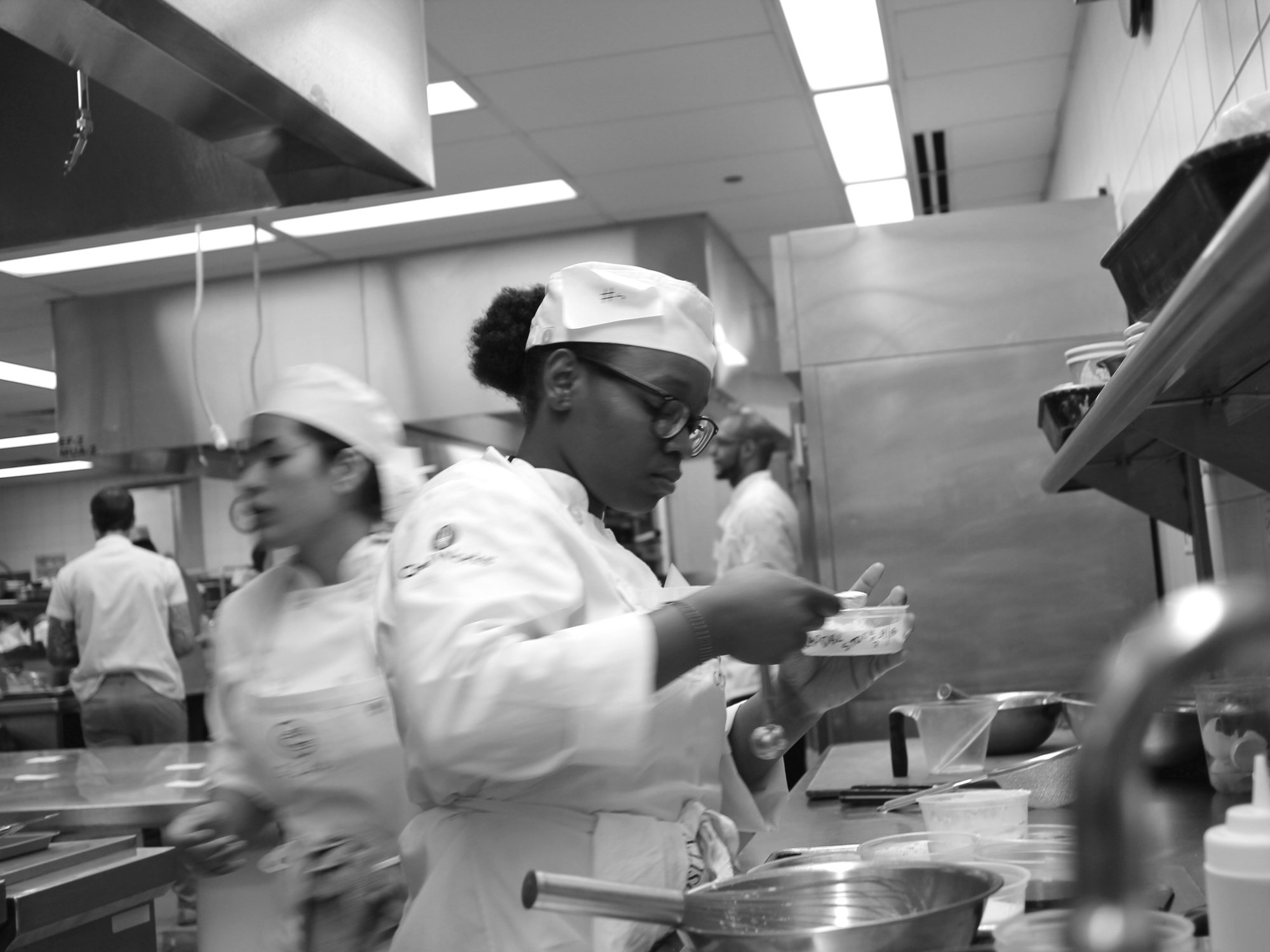I DIDN’T SET OUT TO DO A BUNCH OF WHERE-ARE-THEY-NOW stories about chefs I’d written about in past years. It just happened that when I was talking to Paul Virant, Greg Laketek started shipping salumi again, and then the PR firm for Margeaux Brasserie sent out news about Greg Biggers. But you know, it’s not a bad way to spend the dog days of winter, either, checking in on chefs who’d done interesting things in the past, whether or not they meet other media’s criteria for what’s new and notable right now.
When Greg Biggers was the chef at Café des Architectes in the Sofitel in the Gold Coast, he seemed to me to be one of the most underrated chefs in town—I said pretty much that in Thrillist once. His food looked a little modernist, but really he was a classicist, turning out well-crafted dishes that, even if they were familiar sounding, were always a little better than you expected.
But what was most interesting about Biggers was that at a time when lots of chefs were preserving things in jars, Biggers embarked on an insanely ambitious preservation program for a hotel, in which they made their own salumi and even got a state license to make cheese—something normally reserved for big dairy plants out in cow country, not chichi French hotels in downtown Chicago. I wrote about the whole process of getting the licenses and approvals for the Reader and then again for a site called The New Food Economy:
Biggers found that the best approach was to go to the city with a plan for each new area he wanted to go into, documenting industry best practices for food safety, starting with something as common as sous vide cooking (which officially requires certification, but happens all over town without it). Having laid out what would be a safe way to do what he wanted to do on paper, he then turned to the city’s top food safety official, Gerrin Butler, for blessing. When he got that, he displayed her letters of approval where they’d be the first thing a visiting inspector would see—short-circuiting the inspector’s risk-averse tendency to automatically disapprove of anything different. “They come in and see those, and say ‘Huh, I’ve never seen one of those before. I guess you’re okay,’” Biggers says, with a sly grin.

“I WAS THERE FOR EIGHT YEARS, AND it ran its course,” Biggers says of the Sofitel job, which he left in mid-2018. “It was bought and sold a few times, and they kept cutting things.”
We’re sitting where he ended up—a block away in the Gold Coast, at the posh Waldorf-Astoria hotel, in the third floor restaurant Margeaux Brasserie, which has an impressive view of upscale shopping and in general, looks like Emperor Napoleon III built a sports bar. But first Biggers, who lives nearby, wanted to take the rest of 2018 kind of easy.
Biggers, a native of Florence, Alabama, had teamed up with a boutique owner from his hometown, Jessica Bower, in a Nashville restaurant called Fort Louise. So he was traveling back and forth, overseeing hip comfort food in Nashville a couple of times a month while mostly hanging out with his son. He also did some consulting for other restaurants on HAACP—hazard analysis and critical control points, the system for maintaining food safety he’d had to implement as part of his preservation activities. He hoped to skate through to 2019, but late in the fall a recruiter contacted him about the head chef position at the restaurant from San Francisco’s Michael Mina Group in the Waldorf Astoria.
“It was a long process,” he says. “A lot of their chefs have been in the group for a while, have grown in the company, they’re big on that. I’ve never been involved with them, so interviewing me—it was very intense. I interviewed with Chef Mina, I interviewed with the president of the company, the GM here, the GM of the hotel, the director of operations of the hotel—it was like a six week thing. Afterwards, I asked them, is this normal?” he laughs.
What was here before was fine dining food in a brasserie. And I want to make brasserie food in a brasserie.
“But you’ve seen it,” he says to me. “How many times have you seen outside chefs and groups come in here [to Chicago] and fall on their faces? They were self-aware of that, and after being here a year, they know what Chicago is and what Chicago can do to an outside group.” So they approached being in this market seriously, and Biggers says, “In the end you want them to be careful about hiring—if they’d hired me too quickly, it would have meant that they just wanted to put a body in the spot and be done. As frustrating as it was then, now, it shows that they were serious about making this a flagship restaurant.”
We’re having some breakfast items as we speak, and Biggers points to a block of brioche topped with blueberries and Meyer lemon curd, which he refers to as a Mina Group signature breakfast dish. This isn’t the first time he’s worked for a restaurant group like this—the key experience of his early years was working for Morimoto in Philadelphia—but it’s been a long time since he did.
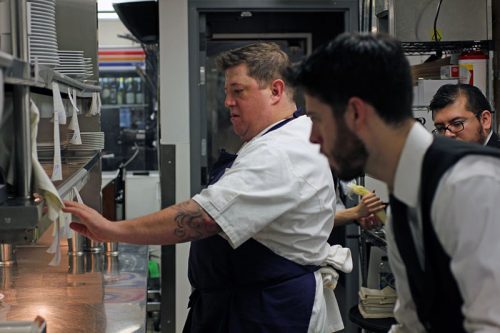
“My concern coming in was, for the past decade and a half, in the positions I’ve had, they’ve been very autonomous. There’s nothing that I had to show to anybody before I put it on the menu,” he says. In particular he knew that Margeaux was modeled after another, very successful restaurant in the group—Las Vegas’s Bardot Brasserie, in the Aria Resort & Casino. Would he be reproducing another restaurant’s menu?
“At the beginning, I got a lot more questioning, a lot more ‘let’s look at this’ sort of thing,” he says. But by now—he’s been on the job about three months—”I’ve proven myself to them, they trust me to do the vision of what this concept is and what it could be.”

MARGEAUX BRASSERIE OPENED IN JULY of 2017, and though the food of Chef Brent Balika and the plush Francophile decor got pretty high marks, one idea seemed to turn up a lot in reviews: expensive. Phil Vettel called the prices “Gold-Coast high,” Jeff Ruby observed that “There’s nothing wrong with that $52 bouillabaisse of Maine lobster, Prince Edward Island mussels, grilled prawns, and toast slathered with rouille, other than the price,” and Mike Sula said that “money should be no object if you choose to visit Margeaux Brasserie.” Biggers talks about the Mina Group wanting to make it an “iconic” Chicago restaurant, but the initial press said “for visitors on an expense account” with a united voice.
“I knew the price point was high—all the reviews said that,” he says. “I got to come in with fresh eyes, and say, I know this neighborhood. I’ve been a block away for eight years. I knew we needed to make it more approachable, make it more user-friendly with the menu. Even with the clientele here, you can’t have a predominantly French-reading menu. I wanted to make it read well and be more fun.”
He gets animated thinking about it. “It’s brasserie food! You can have so much fun with that. There’s so many staples that you can toy with, but not go overboard and scare people away. That was my whole spiel a month in, when they were asking me for feedback. I want this to be fun food, with just enough spin to have some uniqueness to it.”
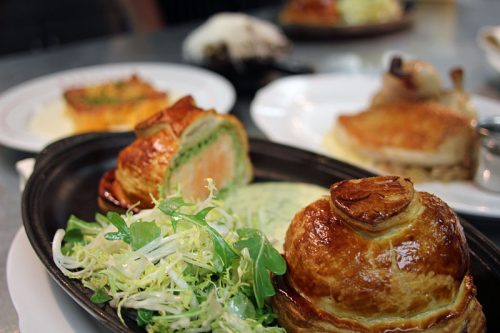
Salmon Wellington and other dishes at the pass
“I knew we needed to be more cost-conscious. We didn’t need the $64 Dover sole, or we could balance that out with some more fish options at a lower price point,” he says. He points to his salmon Wellington, in which a salmon steak arrives grandiosely encased in a puff pastry shaped like a fish, as the kind of thing that delivers on the brasserie concept playfully—but still comes in at $34, a reasonable downtown price and the same as his steak frites.
“We had the high end stuff and no low end or middle,” he says. “I put a burger on the menu, so now you can get a burger. We added a lot more fish, more simple fish, some $26 entrees, things like that. We’re using top end ingredients, and it’s a refined brasserie, but we’ve made a big point of bringing the price points down.”
Within the past couple of weeks he’s changed all the menus at Margeaux, as well as at its street-level cafe, Petit Margeaux, to reflect his approach. “What was here before was very serious cooking, fine dining food in a brasserie. And I want to make brasserie food in a brasserie,” he says.
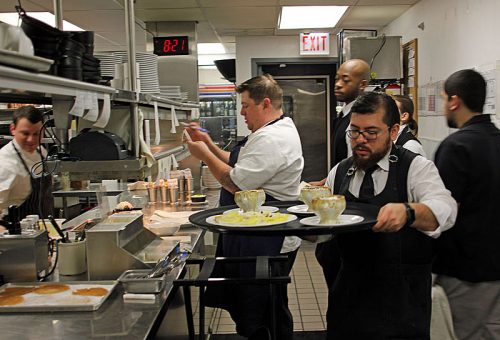
WE GO BACK INTO THE KITCHEN, WHICH I HAD photographed in full frenzy when he invited me in for dinner a few nights earlier as a guest of the house; it’s calmer, now, but you can still see the difference in a hotel kitchen versus a standalone restaurant. Not just that it’s bigger, but that it’s cooking finished meals for somebody, at least 18 hours a day. And the reality is that even the restaurants that aim for a higher mark at dinner are knocking out French toast or chicken caesar salads all day, too. (When this kitchen was Ria’s, Matt Kirkley told me about running out the door to get chicken wings or something at Potash Bros. for the tired guest who didn’t want two-star Michelin food.)
“When I went to Sofitel, I remember standing in the pass—my whole career had been fine dining, dinner only—Morimoto and Tru and McCrady’s. And now it’s like—’fire four foie gras, and give me that hot dog for Room 104!'” Biggers says. “Once I got it, I figured it out—how to balance the level of quality.” He gets a twinkle in his eye and points to a piece of equipment on the pass—a square device with a pump dispenser.
“It’s a nacho cheese machine, like at the movie theater,” I say, a bit dubiously.
“I brought this in—think about it, the new chef comes in and he’s got a $39 cheese pump, they’re all like, who is this guy,” he says. “It works great for serving béarnaise sauce.” He points to a couple of rice cookers nearby as well. “They’re perfect warmers for sauces.”
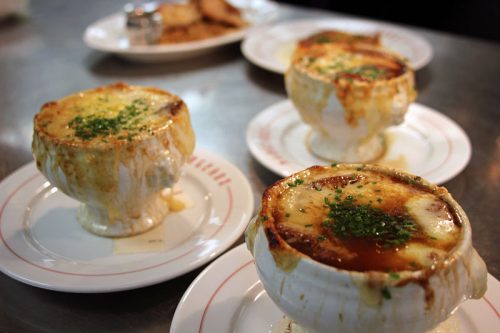
French onion soups
Hotels are famous for having money to spend on gadgets to keep chefs happy and crank out tuna melts faster, so I admire Biggers’ devotion to Target-level technology as long as it gets the job done. If his staff thought him cracked at first, he seems well liked now as he introduces me around, including to a cook and a server who date back to the opening of the hotel (as the Elysian) nine years ago. That’s impressive loyalty that speaks well for the management in charge, and Biggers tells me about a couple of Sofitel people already here or that he brought over, to flesh out the crew with people who know him and he can count on.
“Before I came here, I really had to ask myself, am I going to be able to turn this around?” he says. “I know how people think about hotel restaurants, I know what people thought about this restaurant. Am I going to be able to change it? Because if I’m not, there’s no sense in doing it, because it’s just going to eat me up. So far, it’s been fun, and I’ve been able to put my thumbprint on it, and they’ve been listening to a lot of what I have to say as far as menu pricing, and structure and so on. So, we’ll see how it all plays out.”
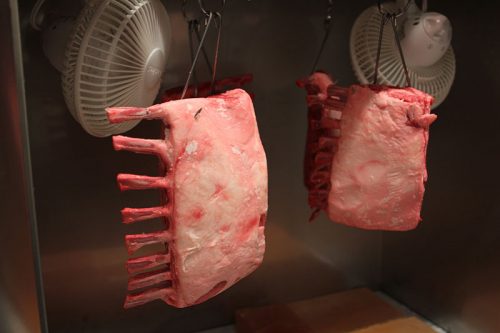
Lamb racks in homebuilt salt cave
He leads me to the corner of the kitchen. We enter the walk-in cooler and he shows me a makeshift dry-aging box, with a couple of cheap fans inside them, helping dry out a couple of hanging racks of lamb over blocks of pink Himalayan salt (to help draw moisture from the air). Earlier in the week I’d seen a picture on social media of chickens hanging in the same place. Removing moisture will concentrate meaty flavor, though this is plainly just experimental quantities at this point.
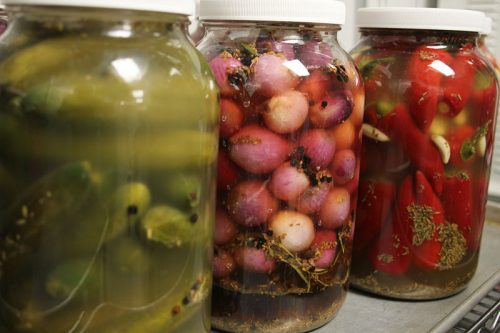
Pickling projects
Outside the walk-in, he’s got jars of onions and carrots pickling in red wine vinegar—”That’s super fun to me, when you go to the markets in the spring and buy way too much stuff and throw it in a jar somewhere”—and above that, jars of mustard seeds, and casks of vinegar, and jars of kombucha, brown liquid with a thin skin atop it. Next to the kombucha are three thick binders—just the beginning of the HAACP logs that will multiply as fast as the cultures they keep track of.
Biggers isn’t going to make cheese or even, likely, salumi in Margeaux’s kitchen, but there are always other things to play with—”Once we get the kombucha going, we’re going to offer it on tap in Petit Margeaux,” he says. A busy hotel kitchen cranking out meals day and night, with room for experimentation and creativity around the edges. Greg Biggers is back in his growth medium.
Michael Gebert plays with food cultures as editor of Fooditor.
Latest
Join the Discussion
After you comment, click Post. If you're not already logged in you will be asked to log in or register with Disqus.





